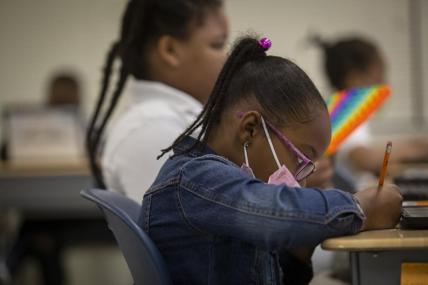Is your child struggling in school? Here’s how to advocate for early intervention
If your child is struggling with classroom learning, early intervention is key. Know your options and how to advocate for them.
Teachers have been coming out of the woodwork, venting on TikTok and Instagram forums about how difficult teaching has become and how many of their students have behavioral or learning issues. Attention spans are down. Kids are acting out. Reading comprehension has suffered.

Perhaps your teacher has contacted you about getting your child evaluated for dyslexia, dyscalculia, sensory processing disorder, ADHD, or autism. This does not mean your child has a permanent disability that will hinder them in the future, in the job market, or in applying for college. Teachers simply want your children to succeed and to make it as easy as possible in the classroom. They want to work with you.
When a child is struggling in school or at home, early intervention is key. There are two routes schools and parents can take: an Individualized Education Plan (IEP) or a 504. Neither of these can be instituted without your consent. Plans are also free for the family.
The nonprofit advocacy organization Understood can give you a full breakdown of the differences between the IEP and 504, but a few distinguishing features are below:
| IEP | 504 |
| Invisible disabilities are often overlooked, even with an IEP | Changes student’s environment only |
| Sets specific, written learning goals | Changes environment and can modify the curriculum |
| The school provides the services | Services can be provided by the school, classroom, teacher, or parents |
| One or more of 13 specific disabilities | Any disability |
| More structured, more personnel and individual dedication to the student | Invisible disabilities are often overlooked even with a 504 |
An expert for Understood, Dia Jackson, told theGrio that a sit-down to create a 504 plan should not be the first time a parent has had a dialogue with a teacher or an educator about their child’s needs in the classroom. Take time between every meeting to educate yourself.
If your kid doesn’t have an official diagnosis and the teacher says nothing is wrong, but you believe your child would be better helped by putting one of these learning plans in place, as a parent, there are a few paths to assessing whether they could benefit from either plan. As a parent who navigated these issues while advocating for my child, here are the strategies that helped our family secure the necessary support.
Pursue a diagnosis outside of the school.
In preschool, my daughter did very well most of the time. Her teacher did not think she exhibited behavior unexpected for her age group. However, she would get in certain moods at school and refuse to listen. At home, she had trouble sleeping, an issue she had since she was an infant. She would be up until the early hours of the morning. She would tell me her brain just “couldn’t think” — or that it felt like it was “on fire” when she was trying to fall asleep. Because her dad has ADHD, there were so many similarities in their personal lives it was clear to me what the issue was.
After trying everything else for her sleep and behavior issues, I took her to a pediatric therapist and made my suspicions clear. By the second appointment, she had been diagnosed.
Set up a meeting to talk to your school’s 504 team
Ask to speak with the school’s 504 team or the assistant principal. Ask the teacher to set up a meeting. Ask someone in administration. Always ask. Schools are much more willing to begin a 504 plan than an IEP because it is less rigid. You can also get your child diagnosed and started on a 504 plan while you pursue an IEP, if necessary.
Jackson is a senior researcher at the American Institute for Research focusing on response to intervention and special education best practices. She said one of the best things a parent can do is to make the school their ally. “Show that you are on the same team. Don’t go into defense mode. You want them to work for you,” said Jackson.
Check on the 504
One of the biggest issues with 504 plans is that they aren’t always enforced. Because these plans are less strict and have less paperwork than an IEP, some teachers will not enforce the accommodations. Check in with your child to see if accommodations are being followed.
If you feel the 504 plan isn’t being followed
- Document what your child says about their accommodations.
- Check in with the teacher to see if they don’t understand the accommodation or don’t know how to implement it.
- Contact your 504 officer and tell them you want a meeting about compliance.
- Consider a complaint with the Office of Civil Rights or your state’s disability protection agency
What to do without a diagnosis
Sometimes, you can’t get a diagnosis — or don’t want to. The teacher is more than likely willing to work with you to make sure your kid is taken care of, especially if it makes their life easier.
When I first met with my daughter’s teacher, I mentioned that my daughter has ADHD and therefore likes to know what happens next in the classroom. Her attention drifts, and she’s aware of that, so it can make her anxious. Her teacher suggested putting pictures of the schedule on her desk so she could see it all the time and have a constant reminder of what happens next.
My daughter does not yet have a 504. While she does have a diagnosis, the assistant principal and I wanted to give her a month to settle into her first full-day public school before we start a plan. So far, my daughter is enjoying herself at school, and the teacher said she is doing well. However, I notice many of her take-home assignments come home incomplete. She also comments that she does not have time to finish lunch.
I know she isn’t purposefully dragging her feet. I know she is trying. She may need some extra time or a fidget toy, so now we move on to the next step, setting up a meeting to create a 504 plan.
Jackson also mentioned that schools should have multi-tiered systems of support for all students, whether a student has a diagnosis or not. “If I were a parent, I would ask the school what your tiered supports look like. ‘My child typically does X, Y, and Z. Is there something we can put in place?’” she said.
What to do with the wrong diagnosis
It’s no surprise that Black kids are treated differently in the classroom. In 2016, Yale’s Child Study Center released a study from a two-part experiment that found persistent racial bias against Black students in classrooms, even starting at the preschool level. Teachers focus on a Black student’s misbehavior more than other students in the classroom.
This can lead to inappropriate diagnoses like conduct disorder and/or oppositional defiant disorder instead of ADHD. Children of color are already more likely to be diagnosed with disruptive behavior, according to studies from NIH, a 2020 study published in Academic Psychiatry, and even the Department of Education.
Do not settle for one of these diagnoses.
If this happens, get another opinion and advocate for your child, especially if you can find a Black therapist who can understand the difference between cultural idiosyncrasies and code-switching versus behavior disorders. When pursuing an IEP, a parent can also ask the school to cover the cost of an outside opinion, whether for the initial diagnosis or the treatment plan. The school may not agree to cover the cost, but the parent is entitled to get one and include it in the IEP if they want.

Aja Hannah is a writer, traveler, and mama. As secretary of the Society of America Travel Writers: Central States Chapter, she prioritizes travel with an ecotourism or human-first focus. She believes in the Oxford comma, cheap flights, and a daily dose of chocolate.
TheGrio is FREE on your TV via Apple TV, Amazon Fire, Roku, and Android TV. TheGrio’s Black Podcast Network is free too. Download theGrio mobile apps today! Listen to ‘Writing Black‘ with Maiysha Kai.


